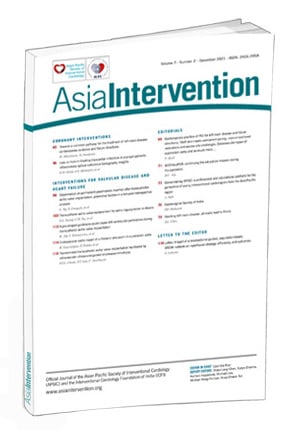The editorial board has been working hard to make this journal the voice of the new generation of interventional cardiologists in the Asia Pacific region. The launch of this issue coincides with the 71st annual meeting of the Cardiological Society of India (CSI), a society formed before the European Society of Cardiology and American College of Cardiology. In this issue, the president of the CSI, Padhinhare P. Mohanan, has written an editorial capturing the complete history of this Society.
The Asian Interventional Cardiovascular Therapeutics (AICT)-AsiaPCR 2021, the official course of the Asian Pacific Society of Interventional Cardiology (APSIC) had a wonderful and very educative meeting on 8 and 9 October 2021. The meeting was hybrid this time, aired from three different studios: Singapore, the host country with a central studio, joined two more studios working simultaneously from New Delhi, India, and Kuala Lumpur, Malaysia. This gave the meeting an opportunity for participation of interested individuals coming from several geographies. Every studio had a physical participation of around 150 delegates. The topics included chronic total occlusions, left main bifurcations, mechanical circulatory support for haemodynamically compromised patients, how to deal with calcified lesions, high bleeding risk patients, intravascular imaging and complications in the catheterisation laboratory, etc. The participation was global. All of the Course Directors did a commendable job of keeping the proceedings very interactive throughout. There were clinical cases and abstract submissions with the best case and best abstracts receiving awards. The presenters have been invited to submit their work for publication in AsiaIntervention.
Non-surgical treatment of complex left main disease continues to draw the attention of most coronary interventionists worldwide, with our region being no exception. Treating this by deploying the latest iteration of stents under intravascular imaging guidance and appropriate drugs is the ultimate aim of the new generation of cardiologists. This issue includes an expert review on the subject by Dejan Milasinovic and Goran Stankovic. Goran Stankovic is widely known and is a highly experienced interventionist who, having mastered the art, has mentored a large number of cardiologists practising vascular interventions. The article contains recommendations regarding selection of cases using a stepwise approach with a judicious use of intravascular imaging, ending the procedure with proximal optimisation. This expert review is accompanied by an editorial by Shao-Liang Chen, another well-known authority on this subject who developed the double-kissing (DK) crush stenting protocol. Shao-Liang Chen comments on the stepwise approach technique and has provided an algorithm for complex left main coronary artery (LMCA) bifurcations.
Transcatheter aortic valve replacement (TAVR) continues to draw attention as the procedure has become streamlined. The indications have now widened to include even native aortic valve regurgitation without aortic stenosis. Systematic data regarding this indication for Asian patients have been lacking. Erica Lauren Soong and colleagues studied the reports of 282 such patients, concluding that this procedure has proven to have acceptable safety and efficacy with a very low mortality in Asian patients as well.
Another continuing issue with TAVR for calcific aortic stenoses has been the need for permanent pacemakers in a highly variable number of patients. In this issue, Lance Ng et al, in a retrospective series of 1,373 patients, have identified factors like dependence on pacing during valve implantation, third degree AV block and mean valve depth of more than 6 mm as predisposing to the need for permanent pacing.
Access-site difficulties can frustrate the operator while they are trying to negotiate the devices through densely calcified anatomies. Innovative use of intravascular, ultrasound-guided shockwave lithotripsy can help, as demonstrated by Paul Chiam and colleagues in an image in cardiology. Other images in cardiology with great educative value and interest in this issue include: OCT demonstrated plaque erosion in a case of AMI treated initially with thrombolysis alone by Suma A. Victor et al; two cases of life-threatening ventricular perforations by pre-shaped wires used during TAVR with the authors, Ryo Abe et al, recommending the use of manually shaped wires. Finally, Rajesh Vijayvergiya and colleagues have shared an interesting image of endovascular aortic repair of a thoracic aneurysm in a porcelain aorta.
We at the editorial board have been working hard to get our Journal indexed in PubMed. I am glad to inform you that, after seven years of effort, the goal is in sight and work on AsiaIntervention is about to bear fruit. Most of the requirements to be indexed have been fulfilled now and we hope to hear the final verdict shortly. Until then, we ask that you continue to submit your work which will be reviewed for the next issues, due to be published in 2022.
